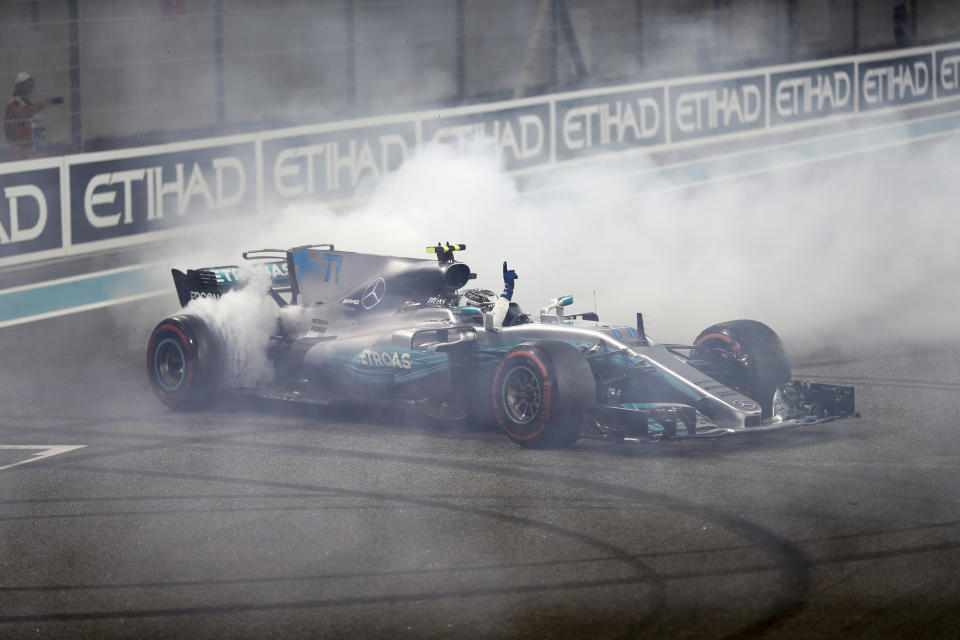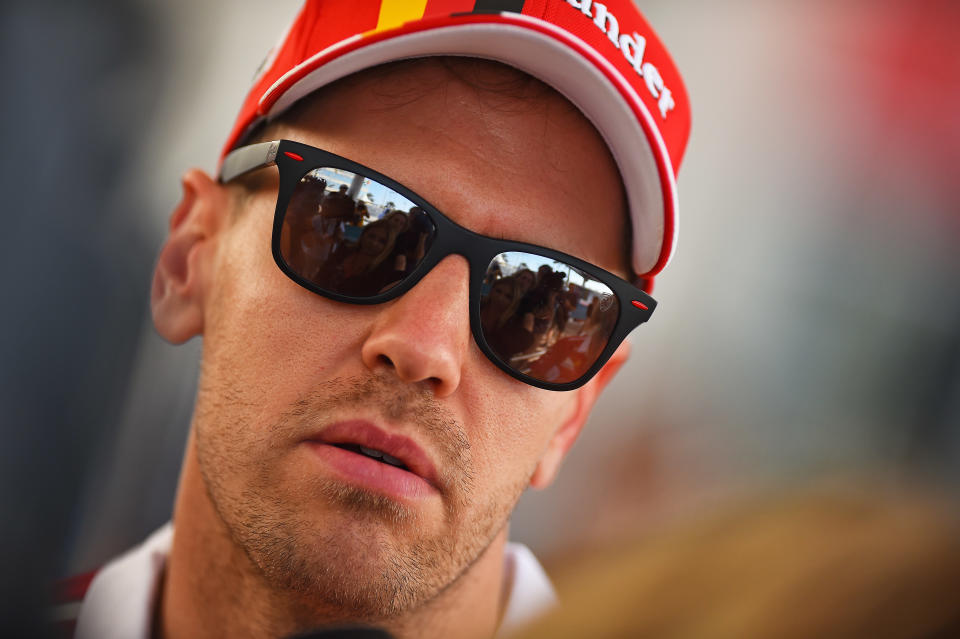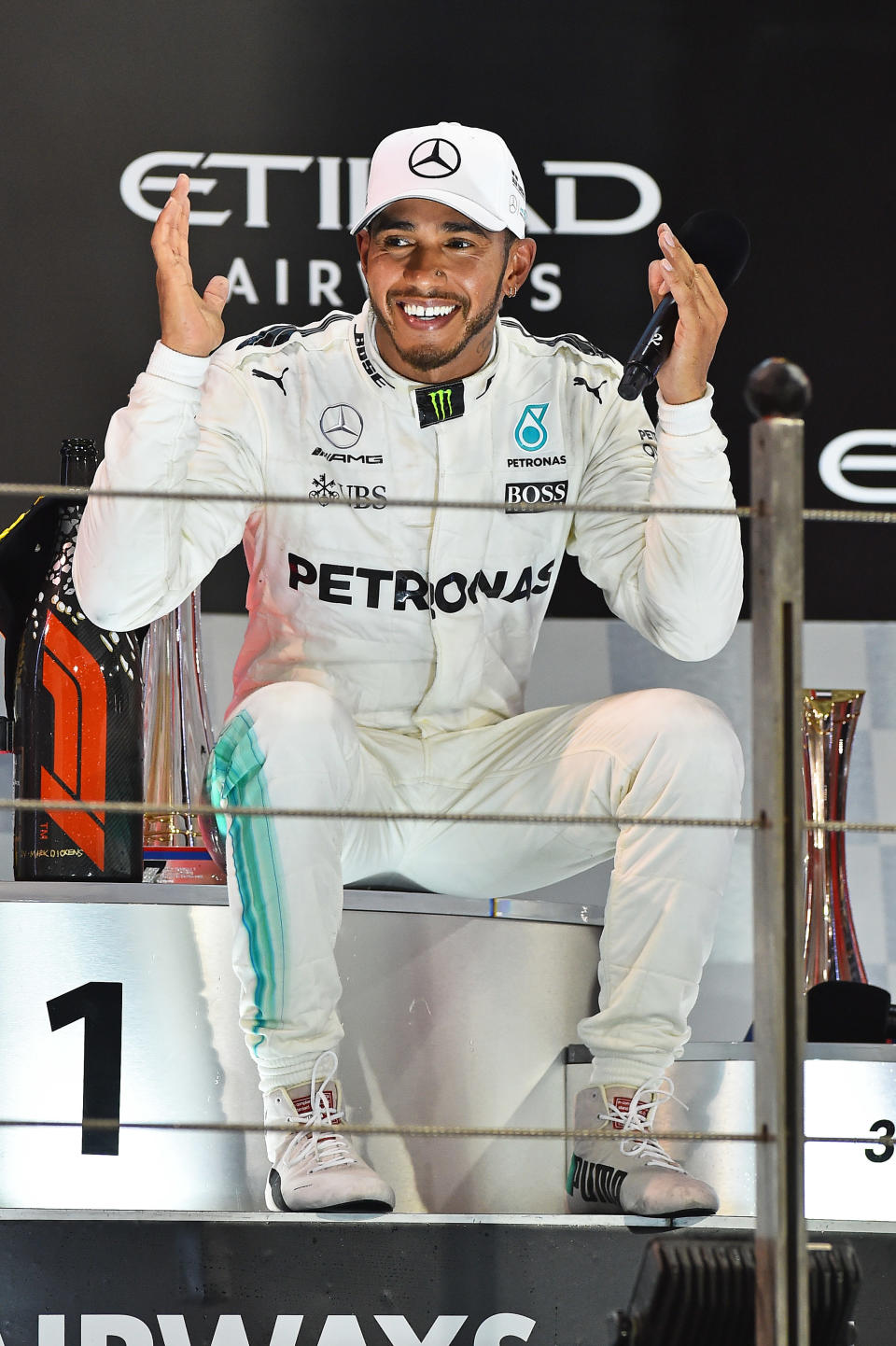Abu Dhabi Grand Prix wrap: F1 takes its final spin for 2017

So Farewell, F1 2017, you promised so much and, a lot of the time, you delivered too.
There was controversy aplenty, wheel-banging racing and a bit of much-needed sparkle injected from the new bosses at Liberty Media.
And then, of course, you blew it with the last race in Abu Dhabi.
READ MORE: Bottas denied second despite serene Abu Dhabi win
READ MORE: Hamilton could do nothing to catch ‘amazing’ Bottas
Money talks. And it says BORING

There is really only one reason why any F1 race takes place, and that’s moolah. Bernie Ecclestone introduced Formula 1 to the art of profit before he morphed that into the art of prostitution, milking the spectacle for billions, as has become traditional in so many top-level sporting circles.
It’s all about the taking part, right? Don’t make me laugh.
The Abu Dhabi Grand Prix illustrates so well what is wrong with F1. It’s a circuit which, in theory, should encourage lots of overtaking but where, in fact, overtakes are rarer than raw meat – and that’s bloody rare.
This track had two DRS (Drag Reduction System) zones, to help cars close up and pass one another – but anyone passing in the first DRS zone was likely to be re-overtaken in the second one. Pah.
The reason these zones are needed is because F1 cars rely heavily on aerodynamic downforce to stick them to the track but, when they travel in turbulent air behind another car, the aerodynamics are disrupted and they start to slip and slide when they should be zooming in for a dramatic overtake.
It’s as if Fifa mandated that all strikers had to wear rollerskates.
Inevitably, this meant far too few overtakes at the Yas Marina Circuit. That’s not to say there was no action but, in all honesty, the Abu Dhabi Grand Prix is regularly a contender for worst race of the year.
So why finish the season with such a predictable anti-climax? Dollar, of course. Big dollar.
It drives the drivers mad too

In the cooldown room after the race, a clearly zonked Lewis Hamilton was in a chatty mood despite finishing second, and he said to race winner Valtteri Bottas (good effort, well done Valtteri) and third-place finisher Sebastian Vettel: ‘It’s impossible to pass here. I think they’ve got to change this track.’
He then highlighted issues with the frustrating third sector, packed with uninspiring right-angle corners, before all three drivers chimed in with ‘Turn one’.
The trouble is, Yas Marina is in many ways a symptom of F1’s problems rather than a cause of dull races. So, while more dollars could be spent tinkering with the Abu Dhabi circuit, that wouldn’t have any impact on the root cause of those problems – the sport’s addiction to aero downforce.
Enough griping about the Abu Dhabi dullness. What was worth watching, apart from an amazing flyby just before the national anthem and the mandatory royal family-size box of fireworks at the end?
Renault fail to shoot themselves in both feet, Toro Rosso mourn

As expected, the best of the action was in the midfield, where Nico Hulkenberg’s battling sixth-place finish leapfrogged Renault ahead of Toro Rosso in the Constructors’ Championship.
Important? Yes, finishing sixth rather than seventh is worth about £5million extra in prize money, to be spent on next season’s Renault challenge.
Hulkenberg was lucky though. He was handed a five-second penalty for cheating by going off the track to overtake Force India’s Sergio Perez on the opening lap and, without a doubt, that illegal manoeuvre was worth more than a five-second punishment.
To rub salt in Perez’s wounds, when Hulkenberg pitted for tyres and his penalty on lap 18, he appeared to serve more than five seconds of penalty and then it took three goes to get his rear right wheel off.
Despite all of that, Perez had fallen too far behind to capitalise on the Renault chaos, and Hulkenberg retained his sixth place. Given how difficult it is to pass at Yas Marina, it’s safe to say things would have been very different had Hulkenberg been forced to give back that position he snatched illegally on the opening lap.
Renault had another disaster when Carlos Sainz left the pits with a loose front left wheel on lap 32. He almost crashed in the exit tunnel before making it on to a run-off area to retire, while the rest of the team sat with heads in hands contemplating an unsafe release and, perhaps, the loss of that important sixth-place finish in the Constructors’ Championship. Mon dieu etc.
Hamilton looked to be giving Bottas a run for his money at one point but, as is the norm for the Mercedes, struggled to stay close in the Finn’s turbulent wake and couldn’t capitalise on the one small mistake Bottas made in the closing stages.
Daniel Ricciardo thumped a barrier and retired with hydraulic problems shortly after – whether duff hydraulics were a result of that thump or the cause wasn’t clear.
And Ferrari ran their own race, Kimi Raikkonen doing enough to stay ahead of Max Verstappen, who struggled with the set-up of his Red Bull all weekend, wrestling with both understeer and oversteer.
Sebastian Vettel… he must have been in the race because he finished third but you’d have been excused for missing him. As the race neared its anti-climactic climax, the German was a distant 20 seconds behind Hamilton and an even more distant 22 seconds ahead of Raikkonen.
He had third place all to himself and that was curiously apt for a man who had threatened to triumph this year, only to see his challenge crumble as the season passed. This will be remembered as Vettel’s What If season.
And Felipe Massa finally signed off, with a tenth-place finish that kept him in the points, even if he was overtaken by Fernando Alonso. A struggling Lance Stroll brought the other Williams home in a distant 18th place, the last finisher.
Stroll needs to work on his consistency urgently – when he’s good, he’s worth his place on merit but on his off weekends, even the money his dad brings to Williams looks like it’s not enough to keep him in F1. He’s not a new boy any longer.
The answer to an F1 question that wasn’t asked

There are certainly some changes that F1 needs to make – see above – but the big changes which are now afoot have nothing at all to do with racing.
The next time you see an F1 car used in anger, it will sport a Halo head-protection device to reduce the risk of drivers being whacked in the helmet (ooyah) by debris.
Like it or loathe it, it’s not been cheap or easy to introduce – so can we have the same attention to detail to the actual racing part of F1 as well please?
On a similar topic, the Abu Dhabi podium ceremony was different for a couple of reasons.
One was the presence of two – count ’em – interviewers (Sky’s Martin Brundle and C4’s David Coulthard) from British telly. I guess Eddie Jordan must have been gaffer-taped to a radiator somewhere with a goldfish bowl rammed over his head.
The other was the unveiling – tadah! – of the new F1 logo.
Again, it’s not cheap to rebrand a multinational operation like F1 so, again, can we see the same effort applied to making the racing more exciting please?
Non entirely surprisingly, reaction to the new logo was lukewarm at best – we don’t always like change in the F1 world, especially when our much-loved and instantly-recognisable old logo is replaced with something knocked up at Hobbycraft.
For the record, F1 owners Liberty Media said the old logo was no good for digital platforms or merchandise.
That’ll be news to the many who use the old logo as their Twitter profile pics. Also, does it mean I get my money back on those stupidly expensive F1 T-shirts then? Huh?
F1 marketing chief Ellie Norman was left to put a bit of PR spin on the thing, saying: ‘The new logo takes inspiration from the low-profile shape of an F1 car – from two cars crossing a finish line.’
It still looks like Trump’s Barnet to me.
Never mind, enjoy the Christmas break and don’t forget the imminent return of Liberty Media’s battery-powered and Barnet-free series, Formula E.
See you in Melbourne next March, for the first of 2018’s 21-race F1 marathon.


